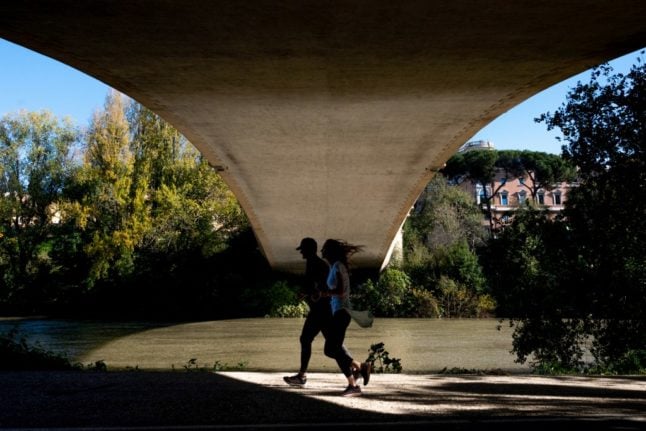No one cares what you wear
Slobs rejoice: no one in this city cares how you dress.
Many Romans wear a tracksuit or loungewear when moving through the city, and having lived here for several years, most of them time I do as them.
There’s a sizeable contingent of middle-aged Roman men for whom a navy windbreaker, almost always accompanied by sunglasses and a bald pate, is practically their uniform (making them look like bus ticket inspectors, whose uniform it actually is).
That doesn’t mean you can’t dress stylishly if you want, or that you won’t see plenty of well dressed people walking around, especially in the more fashionable neighbourhoods near the centre. But you’re not under pressure to dress up if you don’t feel like it.
Unlike some of Europe’s other metropolitan centres, Rome is refreshingly laid back when it comes to things like this – perhaps because the city’s so beautiful no one feels the need to compensate with their clothing.
Or what job you have
This lack of pretension extends to other aspects of life in Rome, too: dogs are allowed in most restaurants, as are small children; and while it’s not exactly taboo to ask people what they do for a living, it’s just not considered that important.
At one dinner with friends, the topic of what everyone did came up. “Io lavoro” (I work) was one person’s response – their assumption being that we were asking simply whether they had a job or were studying, as those are the two options available.
If you’ve lived in cities where the first question you get asked at a party is what you do, it can feel strangely liberating to live in a place that doesn’t care.
READ ALSO: Eight telltale signs you live in Rome
The dark side of this coin is that the reason people don’t often want to talk about work because there are very few good jobs available in Rome. Many Romans who would like to stay in their home town are compelled to go abroad, or at least further north, in search of better career opportunities.
If you’re a foreigner who’s managing to make a decent living in Rome, then, you’re in the lucky minority.

Cash is often preferred
You can use your card at supermarket checkouts or to pay the bill at most restaurants in Rome, and you can sometimes pay by card at cafés and market stalls.
But for most smaller transactions, like paying for a €1.20 cappuccino, cash is expected; and you can anticipate a dirty look, a sigh, or even a flat out refusal if you attempt to pay such a small sum by card.
Just any old cash, though, won’t do – exact change or as close as you can get is what’s wanted, even in supermarkets.
The fact that cash machines in Italy are set up to primarily distribute €50 notes doesn’t help to harmonise the often tense relationship between customer and vendor (most of whom are not shy about making clear that they would rather be doing almost anything other than interacting with you).
All this to say that it will probably get there one day, but as things stand Rome is currently long way from becoming a cashless society.
Bad public transport and worse driving…
I’ll go out on a limb and say Rome’s metro system actually isn’t too bad. But if you need to take a bus or a tram you could be in for a very long wait, and there’s a statistically not insignificant chance it might catch fire with you on board.
As a pedestrian, you must also accept you occupy the bottom rung of the rusted ladder that is Rome’s urban transport network.
Corner junctions that require traffic lights to be safe instead have faded, poorly lit pedestrian crossings – if they have one at all.
READ ALSO: Metro, bus or tram: How to use Rome’s public transport
When you arrive at a crossing, it’s by no means a given that cars will stop for you, so you have two options: stand by the side of the road trying to make eye contact with drivers until one is kind enough to let you cross; or shuffle slowly into the street in a high stakes, very one-sided game of chicken.
Make sure to warn your foreign friends who come to visit so they don’t give you a heart attack by launching themselves into the road without looking, narrowly avoiding being mown down.

… But good long-distance train services
I can’t really give Rome credit for this, but as creaky and decrepit as the city’s local public transport services are, Italy’s long-distance train services are fast and reliable.
Although tickets aren’t cheap, a Frecciarossa fast train will get you from Rome to Florence in 90 minutes, or from Rome to Naples in an hour and a quarter. Milan, all the way up north, is just a three hour train ride away – doable as a long weekend trip.
READ ALSO: Five essential tips to save on train tickets in Italy
Even the slower regional train services are reasonably fast, and good value for money.
And if you drive, your options expand even further: you can be in Abruzzo’s rugged mountains to the East within a couple of hours of setting off, or on the Amalfi coast in three and a half. As travel bases go, Rome is a good one.
A distinctive food culture
Food in the Italian capital is cheap and good – so good that Rome was crowned the best food city in the world in Tripadvisor’s 2022 Traveler’s Choice Awards.
Newcomers might be surprised when they find out what constitutes traditional Roman food, i.e. offal. Tripe, oxtail, liver and tongue are all items you can expect to find on the menu of an old-school Roman restaurant.
These days, however, most diners prefer tamer dishes, which are available in the form of spaghetti carbonara, pasta gricia (similar to carbonara but without egg), or the tomato-based amatriciana – all crowd-pleasing Roman specialties. There’s even an option for vegetarians: cacio e pepe, a kind of gourmet mac and cheese.
While Rome does have a world class food scene, it has nowhere near the variety of international cuisine on offer in a more cosmopolitan city like Milan. In spite of this, there are some good alternatives to the local staples if you know where to go.
Look for establishments (usually found in neighbourhoods outside of the city centre) that mainly serve local diaspora communities who want a taste of home. If there are parts of the menu written in a language you can’t understand, that’s always a good sign. Be respectful: these places will happily serve you, but they probably weren’t made with you in mind.




 Please whitelist us to continue reading.
Please whitelist us to continue reading.
Member comments